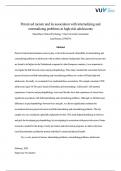Perceived racism and its association with internalizing and
externalizing problems in high-risk adolescents
Masterthese Clinical Psychology, Vrije Universiteit Amsterdam
Lara Henstra (2790274)
Abstract
Perceived racial discrimination seems to play a role in the increased vulnerability for internalizing and
externalizing problems in adolescents with an ethnic minority background. Since perceived racism rates
are found to be highest in the Netherlands compared to other European countries, it was important to
investigate the link between racism and psychopathology. This study examined the association between
perceived racism and both internalizing and externalizing problems in a cohort of Dutch high-risk
adolescents. Secondly, we examined if sex moderated these associations. The sample consisted of 598
adolescents (aged 16-20 years), based in Rotterdam and surroundings. Adolescents’ self-reported
experiences of racism and psychopathology were used. Results show that experiences of racism have
significant associations with both internalizing and externalizing problems. Although we did find some
differences in psychopathology between boys and girls, sex did not significantly moderate the
associations between perceived racism and both internalizing and externalizing problems. The low
sample size was considered a plausible explanation for this. This study helped identifying at-risk boys
and girls for developing psychopathology by investigating its association with perceived racism. Future
research is needed for the design of early prevention and intervention programs, in order to decrease
racial discrimination and thereby protect individual’s mental and physical health.
Key words: perceived racism, internalizing problems, externalizing problems, adolescents
February, 2024
Supervisor: M. Zarchev
,Introduction
Adolescent psychopathology has been frequently conceptualized as two empirically derived syndromes
(Achenbach, 1991): internalizing behavior, which includes distress responses characterized by
depression, fearfulness, withdrawal, anxiety and somatic complaints (Achenbach, 1966; Achenbach &
Edelbrock, 1978), and externalizing behaviors, which overts distress responses characterized by
aggression, defiance and delinquent behaviors (Achenbach, 1991). These behaviors become
problematic when substantial adverse consequences occur for the quality of life of the individual or
others, or when a significant risk to the health and/or safety of the person and/or others is formed (O’
Brien, 2003). Depression affect for instance, is present at 7% till 33% of adolescents (Deković et al.,
2004) and is a strong predictor of suicidal ideation, which is the third leading cause of death in
adolescents worldwide (Cicchetti & Toth, 1998). In addition, 40% to 70% of depressed adolescents
develop a comorbid disorder, with 20% to 50% estimated to have two or more comorbid diagnoses.
This enhances the risk for recurrent depression and to affect the duration of the depressive episode,
suicide attempts, functional outcome and response to treatment (Cicchetti & Toth, 1998). Externalizing
symptoms like aggression, on the other hand, which includes verbal, psychological or physical
aggression, as well as self-mutilation and violent crime, peak in adolescence and are associated with
(preclinical) symptoms of borderline personality disorder, such as impulsivity, intense anger, avoidance
of abandonment and feelings of emptiness (Spaan et al., 2022). Moreover, delinquent behaviors are
associated with physical injury and other risk-taking behaviors, such as alcohol and drug use (Chambers
et al., 2018). Thus, earlier research shows that internalizing and externalizing problems are prevalent
among adolescents and are linked to all sorts of adverse outcomes for individuals’ mental and physical
health.
Adolescents with an ethnic minority background are believed to be at increased risk of
developing both internalizing and externalizing problems (Caldwell et al., 2004; McLaughlin et al.,
2007, Paalman et al., 2015). During adolescence, the awareness of one’s ethnic identity is in
2
, development and individuals start recognizing that the surrounding society’s beliefs, values and norms
differ from their own (Matsunaga et al., 2010). Consequently, being part of an ethnic minority may
complicate the typical identity issues associated with adolescence even more for ethnic adolescents than
for their native peers (Paalman et al., 2015), thereby increasing the risk for psychopathology during
adolescence.
Perceived racial discrimination, that involves unequal treatment based on one’s ethnicity
(Stevens & Thijs, 2018), could be one of the factors that play a role in the increased vulnerability for
internalizing and externalizing problems in ethnic minority adolescents. In this study, perceived racial
discrimination refers to individual racial discrimination, that involves a direct interaction between two
people where one person discriminates against another person (Chambers et al., 2018). This can be
distinguished from structural racism, which refers to embedded racism in institutional practices as
housing, education, employment, health care and the legal system. According to a report of The
Netherlands Institute for Social Research, which examined whether multiple immigrant groups
perceived they were discriminated, over 50% of Moroccan participants perceived they were
discriminated against in public spaces (Andriessen et al., 2014). Moreover, results of the Second
European Union Minorities and Discrimination Survey show that in the Netherlands, 49% of
respondents of North African origins and 39% of Turkish origins have felt discriminated against based
on ethnic background in the preceding 12 months (European Union Agency for Fundamental Rights,
2016). The level of perceived ethnic discrimination was highest in the Netherlands when compared to
all other Member States surveyed. As racially discriminatory experiences indicate that one is not
accepted by others and is therefore being unfairly treated (Stevens & Thijs, 2018), being a target of
discriminatory attitudes or behaviors can be a significant source of life stress (Deng et al., 2010). These
results address the frequency of perceived racism in the Netherlands and underline its importance as a
risk factor for internalizing and externalizing behavior.
3





